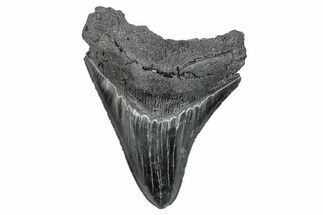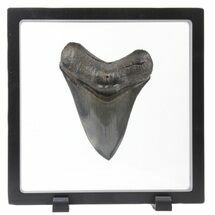This Specimen has been sold.
3" Serrated Angustidens Tooth - Megalodon Ancestor
This is a massive, serrated, Carcharocles angustidens shark tooth. Angustidens is believed to be an ancestor of the fearsome Megalodon shark, though it did not grow nearly as large.
Carcharocles angustiden is a prehistoric, mega-toothed shark that stalked the Oligocene and Miocene epochs' oceans approximately 35 to 22 million years ago. A terror of the open sea and widely distributed, it was only rivaled by other mega-tooth sharks and large raptorial sperm whales that patrolled their gradually cooling oceans. New estimations place C. angustiden length at 31 feet, which is 1.5 times larger than today's great white sharks.
Fierce adults probably hunted small- to medium-sized dolphins, small whales, fish, and sea lions. Their teeth are triangular with fully-serrated edges, perfect to shred a delicious pelagic mammal or chomp a fleeing penguin. The dagger-like teeth display intriguing small cusps at the base of the serrated edges. This feature is pronounced in its ancestors, yet absent in later mega-toothed sharks. It can still be observed as a remnant in C. chubutensis.
Today, many fossil C. angustiden teeth come from the Carolinas where many fantastic Oligocene and Miocene shark tooth fossils are sourced. The Chandler Bridge Formation of South Carolina is a remnant of the Atlantic Coastal Plain where the Charleston Embayment received sediment loads from fluvial systems that buried and preserved excellent specimens. Many exposures have been eroded but some pockets survived in low spots of the irregular underlying Ashley Formation. Fossil evidence depicts a cold water infusion from the north, an abundance of fish, and that beached whales were scavenged by crocodiles.
Fierce adults probably hunted small- to medium-sized dolphins, small whales, fish, and sea lions. Their teeth are triangular with fully-serrated edges, perfect to shred a delicious pelagic mammal or chomp a fleeing penguin. The dagger-like teeth display intriguing small cusps at the base of the serrated edges. This feature is pronounced in its ancestors, yet absent in later mega-toothed sharks. It can still be observed as a remnant in C. chubutensis.
Today, many fossil C. angustiden teeth come from the Carolinas where many fantastic Oligocene and Miocene shark tooth fossils are sourced. The Chandler Bridge Formation of South Carolina is a remnant of the Atlantic Coastal Plain where the Charleston Embayment received sediment loads from fluvial systems that buried and preserved excellent specimens. Many exposures have been eroded but some pockets survived in low spots of the irregular underlying Ashley Formation. Fossil evidence depicts a cold water infusion from the north, an abundance of fish, and that beached whales were scavenged by crocodiles.
SPECIES
Carcharocles angustidens
LOCATION
South Carolina
FORMATION
Chandler Bridge Formation
SIZE
3" long
CATEGORY
SUB CATEGORY
ITEM
#202390
We guarantee the authenticity of all of our
specimens. Read more about our
Authenticity Guarantee.
specimens. Read more about our
Authenticity Guarantee.
 Reviews
Reviews












